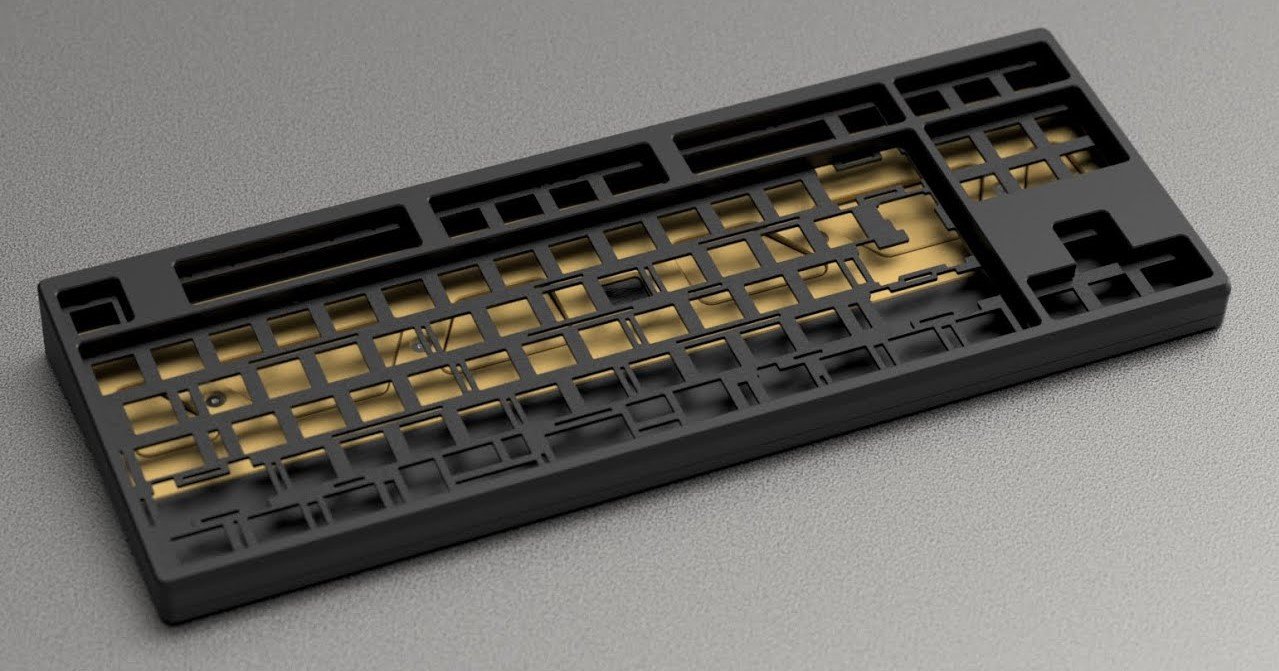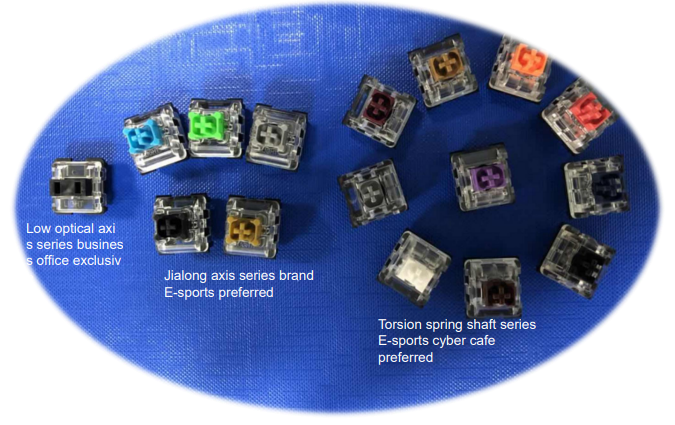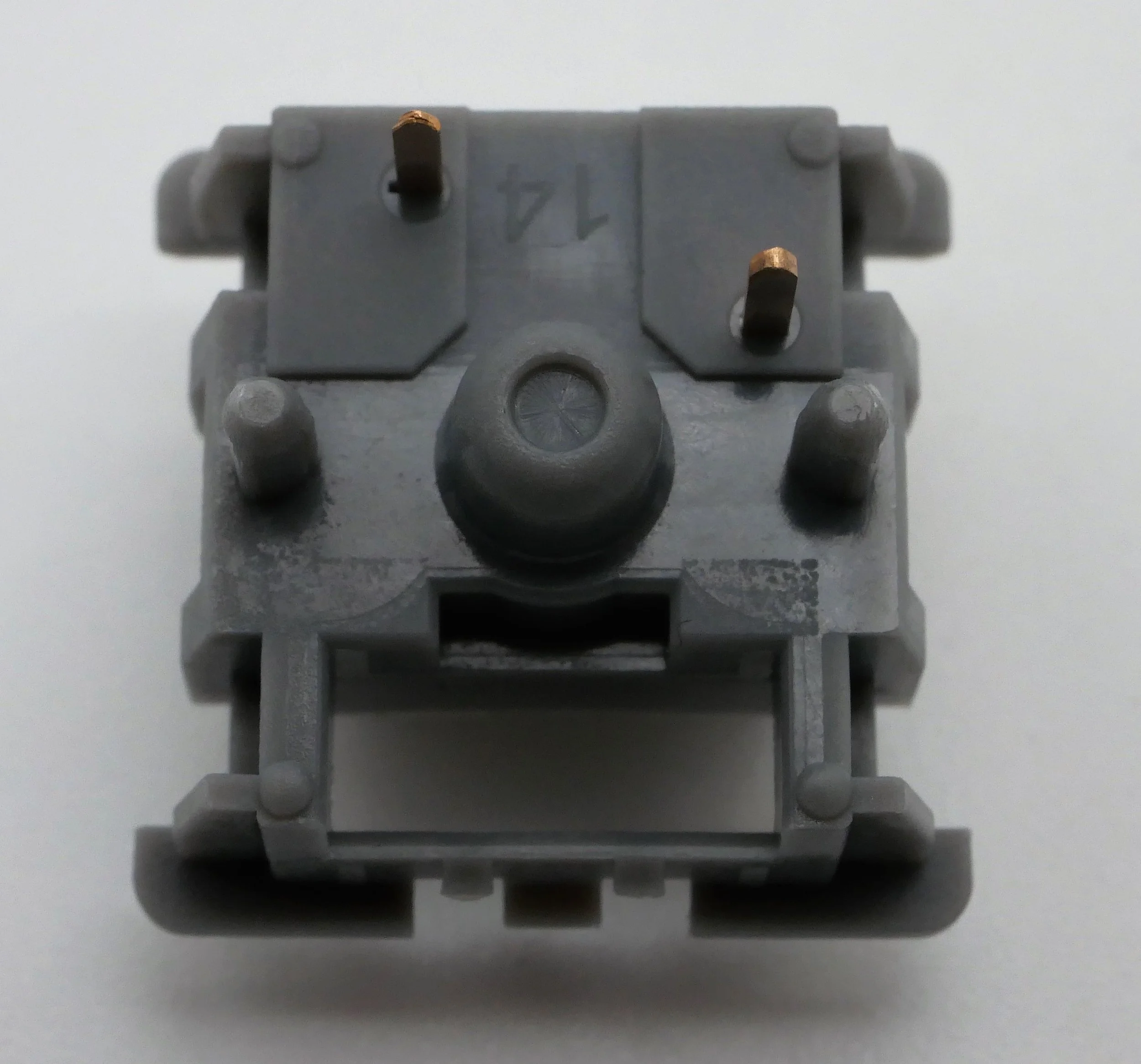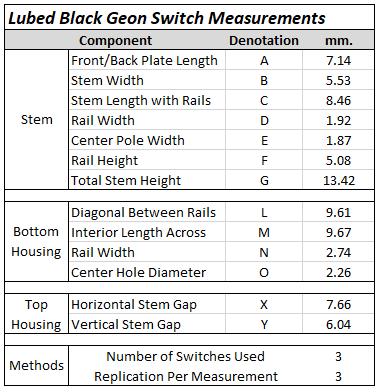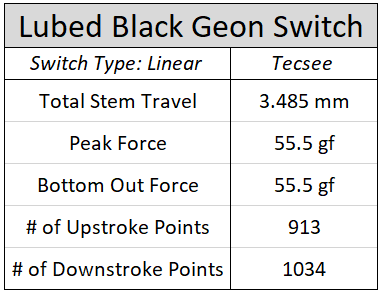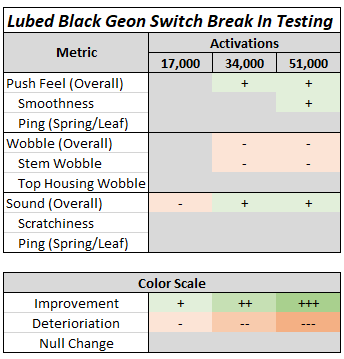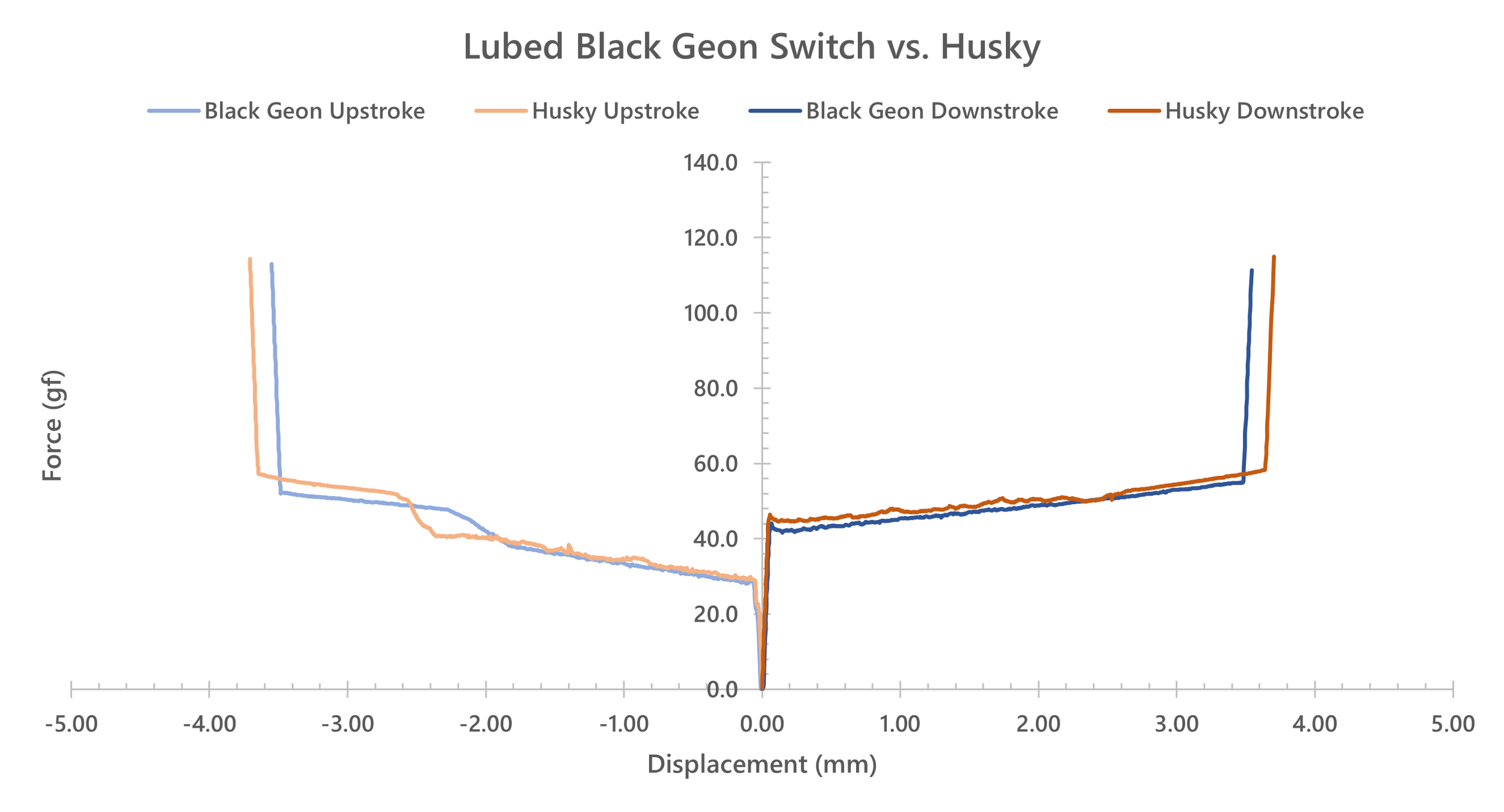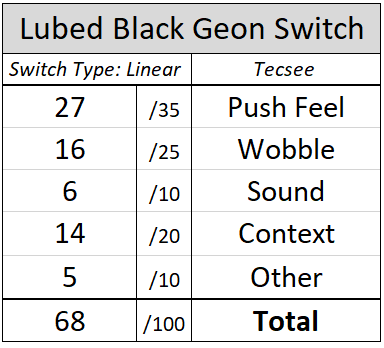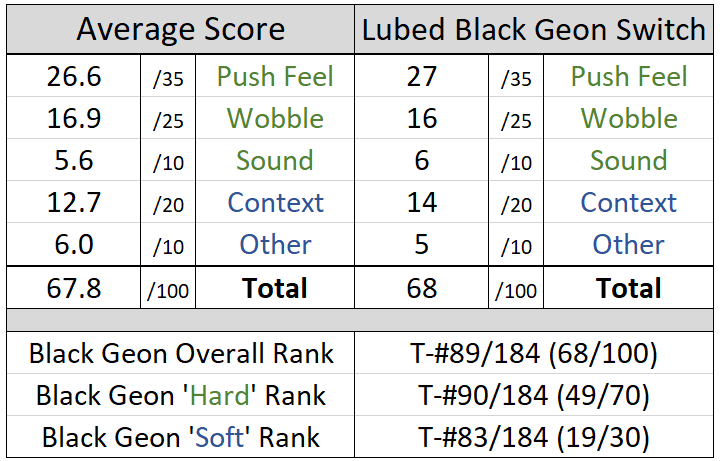Lubed Black Geon Switch Review
This time around, I will be completely honest in saying that I have had absolutely nothing happen in life since the last review that would be worth sharing to kick off an interview. Whereas I normally have at least one interesting night out, or one work-related story to keep things interesting, in the process of saving for the upcoming Minnesota and Nashville keyboard meetups, I’ve found that I’ve spent quite a bit of time just doing nothing. After all, nothing is quite free and helps me save up for my inevitable late-night Culvers stops during my road trip to the Nashville meetup here in a few weeks’ time. And in case anybody is wondering what my personal Culvers order is, it’s normally something to the effect of a chocolate-based Concrete Mixer and at least five orders of the Wisconsin Cheese Curds. Those things are basically cheese balls straight from heaven, and you can’t convince me otherwise.
Figure 1: I’m getting hungry just looking at a menu photo of these things…
While nothing in particular exciting happened to me in the past few weeks, there was some decently exciting news that was passed along to me by a vintage keyboard collecting friend of mine regarding a recent find of theirs. Though I don’t want to include their name or too many details in order to save them from the inevitable DMs about such, I’ll share with you below the first evidence of Hirose HCP Indigo switches. While I’ve previously mentioned these rare and elusive Indigo Hirose switches in my article on 25 Switch Details You May Not Know, the only instances I am aware of those switches feature ‘Cherry’ Hirose housings, rather than the older ‘HCP’ top housings normally seen in Hirose Clear switches. As well, while there wasn’t a second one of these located on the spacebar, my friend also shared a photo of the spacebar switch which was ‘ink marked’ making yet another first time that I’ve ever recalled seeing a Hirose switch with such marking. Even though it is a shame that I don’t personally have it in hands, I’m super glad that I get to share it all with you here!
Figure 2: The first and so far only documented proof of an HCP Hirose Indigo switch.
Figure 3: HPC Hirose Clear switch with ink marking denoting its use as a spacebar.
Switch Background
Just like with any review in which I am touching on the background and historical details of a switch that is hardly beyond the label of ‘brand new’ yet, there quite frankly isn’t all that much history surrounding these switches. First hinted at as early as May of 2022, the Korean keyboard company by the name of GeonWorks teased the future release of stock ‘Geon’ switches alongside their other products. Being much more well known for their high quality, large order size keyboard runs such as that of the F1-8X and Frog, among many others, these Geon switches were aimed to be the first truly custom switches offered by the company since the beginning of their operations in 2020. Surprisingly, this isn’t the first time that such a concept has occurred either, in which a company primarily focused on the design and release of keyboards opts into a custom in-stock switch to sell alongside their kits. Going what feels like quite a ways back, the first and only other pertinent instance of this occurring is that of Mode Keyboards, who released their Reflex and Signal switches around March of 2021 alongside their Mode line of keyboard releases. (To be fully transparent, the only reason I remembered these in the first place is because I photographed them over on my Instagram prior to release…)
Figure 4: Maybe if I'm a good goat the rest of this year then Santa will bring me a GeonWorks Frog...
However, unlike the era in which the Mode Reflex and Mode Signal switches were released, GeonWorks was faced with the significantly more difficult task of narrowing down a manufacturer which could produce custom orders of switches with good enough quality and without much issues with respect to communication. While back in 2021 the only realistic option of doing such for a company not mired in the switch trenches was Durock/JWK, GeonWorks opted to go with Tecsee for the release of their Black and Clear lubed and unlubed switches in July of 2022. Having been around and producing large and small batches of custom switches for some years now, Tecsee is a company well known both on this website as well as to the wider community interested in switches. Though, throughout 2022 I’ve begun to see a not-insignificant shift in the general community consensus on Tecsee towards a more negative tone regarding the switches that they produce and some of their business practices.
Having been inundated with releases upon releases for months (and going on years now), the broader mechanical keyboard community that has remained post-COVID has certainly grown in its skepticism and eye-for-detail with respect to switches. Whereas back in the day “any old switch would do”, I have seen quite a development of complex opinions regarding frankenswitching, modifications, and even specific vendor-sold and manufacturer-made switches that simply didn’t exist in years prior. As well, as Tecsee has begun producing many more custom orders of switches, I’ve heard many people starting to critique some of the finer details of Tecsee. With respect to switches, broad concerns have been raised concerning the factory lubing consistency, mold longevity and consistency between switches, and overall custom-product quality considering the many busts that Tecsee has had over the past few years. Much more seriously, though, many people have begun to take issue with Tecsee’s non product-based business practices.
Figure 5: Some not so successful Tecsee switches that have been released in the past few years including Ethereal Pandas, MK Purple Slushes, and Glorious Lynxes.
Note: In September of 2022, it was confirmed by direct conversation with Mechanicalkeyboards.com employees that the MK Purple Slushes and Holy Llamas were in fact made by Durock/JWK and not Tecsee. Thus, this image and caption are somewhat inaccurate as of updated, current understandings.
Throughout the COVID era and well into the current day, assuming that the current day can actually be separated from COVID for what its worth, Tecsee has shown an increased presence on social media in the form of a relatively active Instagram account that not only interfaces with posts but also reaches out to vendors and users as well. While I have personally been contacted by a sales rep by the name of ‘Nancy’ several times over, I’ve heard of somewhere around three or four different sales rep reaching out over the course of this time and offering anyone with a sizeable platform the opportunity to have a custom order of switches made. That is not to say, though, that these cold calls for switch offerings have just been to vendors and more switch-oriented people like myself. Rather, these DM sales offers have purportedly been going out to anyone and everyone with a sizeable following, a store that sells keyboard products, or anyone they feel might be capable of completing a sales with and with a significant amount of pushing at that. Having been asked my general feelings about the hard, switch-related issues raised in the paragraph above, as well as about these potentially subtle, predatory business practices, I’d have to admit I’m a bit squeamish to respond. While I certainly don’t think these are all positive things, I do want to provide a few pieces of commentary that have come to my mind over the course of the past week that I have not heard people discussing in conversations about Tecsee:
-1. Vendors and Designers who use Tecsee to the best of their capabilities have produced and continue to produce excellent, well selling switches.
Figure 6: Some well-received and high selling Tecsee switches from previous years including Kinetic Labs' Huskies, Cannonkeys' Neapolitan Ice Creams, AEBoards' Naevies, and Bolsa Supply's Corsas.
Most of the criticism regarding the current state of ‘quality’ of Tecsee’s switches seems, to me at least, to be focused around low effort custom orders of switches. These could be switches that simply have some color options slapped onto a spin-the-wheel selection of housing materials and Tecsee’s name on it to the low effort, basic font ‘imprints’ of custom nameplate orders. While switches such as the Ethereal Panads are in fact made by Tecsee and indicative of offerings they do have, I would strongly argue that neither of their parent companies put significant time into developing these switches. Rather, vendors such as AEBoards and Bolsa Supply seem to be producing large amounts of well-selling Tecsee switches after having put in significant amounts of time and effort into the development of the Naevies/Raeds and the Zakus/Corsa/Techno Violets, respectively. As well, less dedicated ventures such as Cannonkey’s Neapolitan Ice Creams and Kinetic Labs’ Husky/Salmon switches show that vendors don’t need to sink their entire line of switches and months or years of development into producing unquiet or good switch offerings. To this end, Tecsee and the quality you get from Tecsee, appears to me at least to be a direct function of the effort and quality put into that of the design of the switches.
-2. The rapid prototyping of switches in very small batches is something that no other switch company offers as competitively as Tecsee.
Figure 7: TofuTypes' rounds of prototype switches trying different housing materials and stem lengths for personal projects.
While Nancy, the sales rep from Tecsee whom I’ve spoken with the most, has offered me small batches of switches of x, y, or z specifications for ‘testing’, I have never quite been interested in this prospect. Streamer and YouTuber TofuTypes, however, has been much more interested in this process and has gone through the process of ordering small, custom order design batches from Tecsee at least a half dozen times from what I can tell. First debuted in his March of 2022 video titled ‘MY OWN SWITCHES ARE HERE’, TofuTypes demonstrates a few thousand of truly custom-ordered, to his liking switches that Tecsee produced him with relatively minimal turn around time. To put it bluntly, this is incredibly rare in the grand scheme of keyboard switches. Other manufacturers, even smaller and lesser well known ones, often set pretty hard minimum order quantity (MOQ) limits that start in the 5 digits. Larger companies like Kailh or Gateron, on the other hand, are known to be many times higher than that. So to that end, the fact that there is a reputable keyboard switch manufacturer out there who is offering these kinds of opportunities for individuals who are less flush with cash than large vendors is truly an option that should not be looked down upon at all. In fact, I would imagine this flexibility in time will likely lead to even more interesting switch creations in the coming years since the design and customization process is less attached directly to large vendors selling these switches.
-3. While I agree that Tecsee’s predatory sales practices are not the best look for them, it is hardly outside of the norm for switch manufacturing companies.
Figure 8: Sample switches from a brochure of a very much unknown switch manufacturer who reached out to me last month.
To start out this paragraph, I do want to make it clear that I am not in favor of Tecsee reaching out with sales pitches to small content creators, or really anyone who isn’t an established vendor for the record. These types of people often are not entirely aware of what it is they could or should be asking of Tecsee, and are perhaps prone to just producing more switches of subpar quality not really knowing what buttons to press to end up with the next Naevy or Corsa switch. However, this is only the first time that people are really discussing this broadly as its the first time a company of any substantial size has started choosing to reach out to smaller creators. For as long as I’ve been writing reviews on this blog, and for as long as some vendors have been in business, cold call offerings for switch manufacturing and/or samples has just been a feature of the territory. Just this year alone I’ve received a half dozen emails from manufacturers even I have never heard of before talking about producing switches and/or showing me brochures of what they could make upon request. While I certainly don’t think that this practice is the best move for these companies, I can understand why they choose to do such and how its not as problematic when it is targeted at more discerning, knowledgeable individuals like myself. So to that end, even though its new for the vast majority of the community out there to hear of this practice for the first time, I want to make sure that you all are aware that it is far from uncommon at this end of the hobby.
So with all of that in mind, I can’t really say that I am necessarily fully in favor of Tecsee’s decisions nor am I strongly posed against them either. Even though this background section has turned into a bit more of a meta-commentary than normal, I find these things both important and seldom if ever mentioned in discussions about Tecsee and their switches. As well, to pre-emptively defend GeonWorks and their decision to go with Tecsee prior to writing the actual performance section below, I would strongly encourage people to judge Tecsee switches not under one umbrella but rather on a case by case basis. As stated above, I really feel that the quality and effort put in with Tecsee lines up with the quality and effort returned.
Rounding this all back out such that it ends in a normal ‘Switch Background’ section fashion, the GeonWorks ‘Geon’ switches first went up for sale around July of 2022. While initial teasers of these switches suggested that two linear (Black, Yellow) as well as one tactile (Clear) variant would be available options, only Black and Clear switches have been released as of the time of writing this review. Baring no distinctive name nor features to refer to them by other than their ‘GEON’ nameplates, these switches are currently stocked by GeonWorks in packs of 35 and come in lubed and unlubed varieties of the Black and Clear versions. Interestingly, its worth noting that both the lubed and unlubed variants of these switches are being sold at $0.50 per switch, which is ever so slightly below the average selling price of custom-ordered Tecsee switches as of the time of writing this.
Lubed Black Geon Switch Performance
Note: In order to produce the most transparent and bias-free review that I can, I want to note that I was sent these switches by Geon without asking for them. I did mentally have interest in reviewing them prior for numerous reasons and chose to review them of my own accord without any notice made to Geon nor GeonWorks regarding such review. No compensation nor payment was made in exchange for this review or for any of my reviews, for that matter.
Appearance
Figure 9: Lubed Black Geon switch and components.
At the highest level, all of the Geon switches come in a monotonal, dark grey-colored housing with a stem color denoting their type based on traditional switch stereotypes. For those of you who are unaware of these stereotypical colorings that were established long before the custom switch scene: Red, Black, and Yellow often signify linears; Blue and Green signify clickies; Brown and Clear signify tactiles. In terms of overall color, the grey housings sit in between that of the SP Star Meteor Grey housings and the Designer Studio Graphite Golds, taking on a darker but still distinctly grey tone. The only outward feature denoting these as ‘Geon’ switches are that of the stylized ‘GEON’ nameplate that is the same across all variants of switches. All other distinctive features of note are discussed below in the piece by piece break down.
Figure 10: Color comparison between DesignerStudio Graphite Gold (Left), Lubed Black Geon Switch (Center), and SP Star Meteor Greys (Right).
Looking first to the top housings of the Lubed Black Geon switches, externally they are as relatively plain and simple as the last paragraph may have led you to believe. In addition to their dark grey color, they also feature a wide, full length rectangular LED bar with a guiding circular indentation in the center for through-switch LED placement. The stylized ‘GEON’ nameplate appears in ever so slightly raised letters pressed into the top housing with the faintest outline of the ‘nameplate rectangle’ evident when holding the parts up to a bright light or inspecting them closely. Internally, these Geon switch top housings are very much in line with the mold designs of more recent Tecsee releases and don’t feature any drastically different details worth noting. As was similarly noted in the Naevy V1.5 Switch Review which I wrote, the mold markings of the Geon switches are located on the interior LED-slot lip, and come centered with a single number marking. Interestingly, when I was exploring these switches for mold markings, I actually came across a top housing that had absolutely no mold marking whatsoever as can be seen below in Figure 13. While you would think that I would have come across this before, this is the first time I have ever recalled coming across such.
Figure 11: Lubed Black Geon switch top housing externals showing rectangular LED slot and stylized 'GEON' nameplate.
Figure 12: Lubed Black Geon switch top housing internals showing centered, single number mold marking next to LED slot.
Figure 13: Lubed Black Geon switch top housing showing no mold marking in traditional location next to LED slot.
Moving next to the stems of the Lubed Black Geon switches, these come yet again with very little in the way of surprises with respect to mold designs and features. The slider rails are slightly tapered, the center pole has a hard tiered design, and there are a small set of medium depth mold ejector circles directly over that of the stem legs on the front plate – all features which are perfectly in line with Tecsee’s previous releases. Interestingly enough, these switches are said to come factory lubed but don’t immediately to the eye register as such with the exception of some of the stem legs which I checked out. Upon inspecting these Lubed Black stems by touch, however, it was very evident that I was physically removing lubricant to the touch and smearing it around on the various surfaces. It does appear that there is a thin but noticeable to the touch amount of lubricant applied to the front and back plates as well as the slider rails of the Lubed Black Geon switches.
Figure 14: Lubed Black Geon stem showing tiered central pole, tapered slider rails, and front plate mold ejector circles.
Finally arriving to the bottom housings, they bare a little bit more interesting detail than the previous two pieces, though not to such a significant degree that they stand out amongst the backdrop of all Tecsee switches. Internally, there are 8 mold ejection circles along the upper rim of the bottom housing, a subtle south side spring collar, as well as slightly raised regions around the central mast and at the bottom of each slider rail. The LED slot on the bottom housings is entirely wide open allowing for the largest range of LEDs to be used in conjunction with the wide LED bar on the top housings. On the underside, the Geon switches come in 5-pin/PCB mount configurations and bare a single mold marking in between the metal PCB pins. As far as I can tell, this mold marking is always a one or two-digit number and appears a different texture than that of the bottom housing panel it resides on.
Figure 15: Lubed Black Geon switch bottom housing internal design showing mold ejector circles, shallow south side spring collar, and lube on leaf.
Figure 16: Lubed Black Geon switch bottom housing exterior design showing wide open LED slot and mold marking between the PCB pins.
Push Feel
All things considered, for being budget Tecsee-made switches without all that much customization seemingly requested with them, the Lubed Black Geon switches are actually pretty solid linear switches. In terms of smoothness, they are decently smooth while still retaining some of the ‘character’ feeling of the actual materials used in the housings. Across the batches I received there was some presence of occasional small grain scratch in some switches, though as can be seen below it would appear that actuation time more or less resolves the issue. Compared to the non-lubed Black Geon switches, the minor amount of factory lubing that is present becomes immediately more noticeable and surprisingly well received. While I could imagine that some people would instinctively choose dry switches with the intention of lubing the switches themselves, one could easily lube on top of the factory lubrication without it being overlubed in the end result.
As for the housing collisions, the Lubed Black Geon switches sit both above and below my expectations at the same time, straddling that fence like some sort of simile I can’t quite finish to save my life. Sure, I went into this expecting some sense of dread at the cursed combination of long stem pole, polycarbonate top housings, and nylon bottom housings. Overall, though, the difference between topping and bottoming out isn’t as drastic as I’ve seen otherwise with this combination. While the topping out is distinctively thinner and sharper than the bottoming out, a feature which only gets worse with higher activation speeds, it still just doesn’t quite hit the same plasticky thinness in feeling that is typically associated with polycarbonate top housings. Additionally, the fact that the stem appears to only barely bottom out onto the stem pole makes for both a much more natural travel distance around 3.50 mm as well as a less harsh and still somewhat nylon-like bottoming out feeling.
Regarding the force curve diagram for the Lubed Black Geon switch, as shown below in Figure 17, the marketing for this switch is more or less spot on. The stems appear long in length with a very spot on 3.50 mm travel distance, and a roughly 60g weight bottoming out force. (Note that normal springs are within factory specifications at +/- 5g from listed weight.)
Figure 17: Lubed Black Geon switch force curve diagram.
Sound
Often times in the ‘Sound’ section of reviews I try and note differences in the sounds of switches as a function of their typing speed. When switches have thinner housings or sharpened, pointed bottoming outs on stem poles, I find that their sound becomes more intense at higher actuation speeds leading to a much different sounding switch than at lower actuation speeds – and that is even just in hand, not in any sort of builds. To my surprise, the Lubed Black Geon switches are one of those switches which swing widely in terms of sound as one increases actuation speed. At lower actuation speeds, these switches are surprisingly well balanced in terms of sound, accentuated at either end with pointed, medium sounding collisions with a bit of bass backdrop. As speed picks up, though, the topping out begins to separate itself more and more, becoming increasingly more thin, pointed, and sharper in sound at faster activation speeds. In total, it is as if these switches have a sort of ‘progressive polycarbonate over nylon sound’ to them that only becomes noticeable as one’s typing speeds pick up.
Wobble
In terms of straight up stem wobble, the Lubed Black Geon switches have a moderate but not likely bothersome amount of stem wobble in both directions. Slightly greater in magnitude in the N/S direction than that of the E/W one, the stem wobble is likely going to be bothersome to those sensitive to wobble and/or using tall keycap profiles with these, but it likely won’t be overly problematic to the vast majority of users. In a similar sense, as well, there is an ever so slight amount of N/S top housing budge that is present in about half of the switches that I received in my batch. While this certainly drastic enough to necessitate films for using these switches, I would imagine that this would be a good case where they could be used to tighten up the tolerances a bit.
Measurements
If you’re into this level of detail about your switches, you should know that I have a switch measurement sheet that logs all of this data, as well as many other cool features which can be found under the ‘Archive’ tab at the top of this page or by clicking on the card above. Known as the ‘Measurement Sheet’, this sheet typically gets updated weekly and aims to take physical measurements of various switch components to compare mold designs on a brand-by-brand basis as well as provide a rough frankenswitching estimation sheet for combining various stems and top housings.
Figure 19: Lubed Black Geon switch 'butterfly style' force curve diagram.
The latest in the content-adjacent work that I’ve picked up, the new ‘Force Curve Repository’ is now hosted on GitHub alongside the Scorecard Repository and contains all force curves that I make both within and outside of reviews. In addition to having these graphs above, I have various other versions of the graphs, raw data, and my processed data all available for each switch to use as you please. Check it out via the ‘Archive’ tab at the top of this page or by clicking any of the force curve cards above.
Break In
Break In Notes
17,000 Actuations
- Compared to their stock versions, the Lubed Black Geon switches are actually pretty resilient to break in testing up to 17,000 actuations. The overall push feeling and stem wobble are both impossible to differentiate at this break in point versus their stock form.
- Resiliency in many areas aside, there is some sort of variability particularly in the housing collisions at this point that I feel is worse than the stock form. While I had initially just guessed this to be a function of the factory lubed distributing over time, the fact that this feature disappears at longer break in periods sort of sets that narrative in stone for me, personally.
34,000 Actuations
- In a surprising 180 degree turn, at 34,000 actuations the Lubed Black Geon switches surprisingly not only become a lot more cohesive across their batch as opposed to the 17,000 actuation switches, but are even ever so slightly than their stock form. This is especially noted in the overall uniformity of the push feeling and the sound.
- Unlike the 17,000 actuation and stock switches, though, the Lubed Black Geon switches do have marginally greater amounts of wobble in both directions. Comparing them against their stock form, this is especially noticeable in the E/W direction which has a bit more play to it than the N/S direction.
51,000 Actuations
- Whereas the 34,000 actuation switches had a noted overall improvement in push feeling consistency both throughout each switch’s stroke and across the batch that was tested, the 51,000-actuation set feel just a touch bit more smooth. This is to enough of an extent that I would imagine that breaking these switches in to this point evenly has distributed the factory lubing around quite a bit.
- The same issue with respect to stem wobble, and particularly that in the E/W direction is noted here in the 51,000-actuation set as was previously noted in the 34,000 actuation set. It should be known that there wasn’t any sort of drastic increase in this stem wobble in between these two break in points, and the difference is noted when compared to their stock forms.
Other
Having arrived at the informal packaging teardown part of this review, I have to say that completely absent of all of my aforementioned feelings about these switches and how they perform, the packaging on these switches absolutely slaps. Coming in packs of 35, all of the Geon switch boxes are a simple white and grey, thin box with denotation as to what type of switches they contain on the front and a nice component detail breakdown on the back side. Inside of each pack, there are thin plastic retaining trays identical in nature to that of the trays that have been used previously in Gateron Holy Panda X and Chosfox x JWICK Voyager switches. Unless I am (probably) forgetting about some other release from Tecsee, this is the first time which Tecsee has implemented the white tray design as packaging for switches, being third behind Gateron and Durock/JWK to implement this in switch releases this year.
Figure 22: GeonWorks switch packaging front and side.
Figure 23: GeonWorks switch packaging back and side.
Figure 24: GeonWorks Black Geon switch packaging tray and top retaining shell.
Figure 25: Switch packaging trays released in 2022 including Gateron HPX, Chosfox x JWICK Voyager, and Lubed Black Geon switches.
Comparison Notes to Other Notable Linear Switches
Note – These are not aimed at being comprehensive comparisons between all factors of these switches as this would simply be too long for this writeup. These are little notes of interest I generated when comparing these switches to the Lubed Black Geon switches side by side.
Figure 26: Switches for comparison. (L-R, Top-Bot: Gateron KS9 Pro 2.0 Yellow, Zepsody Bluebonnet, Ajazz x Huano Peach, Gateron Oil King, KTT Strawberry, and Husky)
Gateron KS9 Pro 2.0 Yellow
- In much a similar fashion to that of the KTT Strawberries, the KS9 Pro 2.0 Yellows are much smoother than the Lubed Black Geon switches, though occupy a much more heavily applied end of the factory lubrication spectrum.
- There is much less stem wobble in both directions in the Gateron KS9 Pro 2.0 Yellows than there is in the Lubed Black Geon switches.
- In terms of overall sound, the Geon switches are not only significantly louder, but carry a much more clashing, plasticky like sound to the topping out when compared next to the Pro 2.0 Yellows.
Zepsody Bluebonnet
- The Zepsody Bluebonnet switches are much more scratchy than that of the Geon switches, having a large grain, sandpaper-like quality to their scratch as to the subtle grain scratch sporadically present in some of the stock Geon switches.
- With respect to their overall volume and sound, the Lubed Black Geon switches have a bit more of a sharp popping sound that is both louder and a little bit less subtle than that of the Zepsody Bluebonnets.
- Of all of the switches in this comparison list, the Bluebonnets and the Lubed Black Geon switches are the most comparable in terms of stem wobble, with the Geon switches having perhaps the slightest edge on that of the Bluebonnets.
Ajazz x Huano Peach
- There’s a subtle amount of spring ping present in some of the Ajazz x Huano Peach switches which simply is present in that of the Lubed Black Geon switches.
- While neither are perfectly smooth, I think that the smoothness and/or scratchiness of these two switches is the most similar out of any of the switches made in this comparison list.
- In terms of stem wobble, the Ajazz x Huano Peach switches are significantly less wobbly than that of the Lubed Black Geon switches.
Gateron Oil King
- While both of these switches have a topping out that is noticeably different in feeling than that of their bottom out, the difference is much more noticeable in the Black Geon switches than that of the Gateron Oil Kings.
- Interestingly, while the Black Geon switches are lubed significantly thinner than that of the Gateron Oil Kings, they are at least competitively smooth and not absolutely blown out of the water by the Oil Kings in comparison.
- There is a bit more stem wobble in both N/S and E/W direction in the Geon switches than that of the Oil Kings.
KTT Strawberry
- In terms of both push feeling and sound, the Black Geon switches are significantly more present, forceful, and louder than that of the KTT Strawberry switches.
- Not to much surprise, but even though both of these switches are decently smooth, the KTT Strawberries have much more of that ‘perfectly hand lubed’ feeling to them as opposed to the raw, smooth-by-material Black Geon switches’ feeling.
- There is significantly less stem wobble in both the N/S and E/W directions in the KTT Strawberry switches than that of the Lubed Black Geon switches.
Husky
- While similar in overall volume to each other, the housing collisions of the Husky switches are a bit more thin feeling and sharper in tone.
- In terms of smoothness, the Lubed Black Geon switches are a decent bit more smooth than the Husky switches. Additionally, the consistency surrounding this metric is better as well in the Black Geon switches.
- There is much more E/W stem wobble in the Black Geon switches than that of the Husky switches.
Scores and Statistics
Note – These scores are not necessarily completely indicative of the nuanced review above. If you’ve skipped straight to this section, I can only recommend that you at least glance at the other sections above in order to get a stronger idea of my opinion about these switches.
Push Feel
Coming in a polycarbonate over nylon housing design with a thin amount of factory lubing applied, the Lubed Black Geon switches are a decent performing, medium weighted linear switch. While there consistency across the batch in stock form is a tad bit spotty, overall the average switch is smooth to the touch with a well-balanced set of housing collisions. As typing speeds pick up, though, the polycarbonate topping out becomes more and more pointed in turn.
Wobble
These switches are fairly average with respect to their stem wobble, having a potentially but not likely super problematic level of stem wobble in the N/S and E/W directions. (More so in the N/S than the E/W though.) As well, in about half of the switches of the batch that I received there was an ever so slight N/S top housing budge that may lead to these switches benefitting with the implementation of switch films.
Sound
Surprisingly, at normal actuation speeds these switches sound fairly well balanced with a slightly pointed, medium tone stem-pole based bottoming out and topping out with a slightly bass-y backdrop. As typing speeds increase, the top housing takes more of a front and center role taking over with both a sharper, higher pitch and a louder overall volume.
Context
Released as an in-stock switch option alongside GeonWork’s keyboard offerings, these switches offer solid performance at a $0.50 per switch price tag and easily serve as great introductory switches for people pulled in by Geon’s boards alone. While there is still room to improve, these switches do come at a fairly good price per performance point.
Other
In much the same way as the Mode Reflex and Signal, I’m glad Geon has brought these along not as the next innovative switch options, but as an easy all-in-one-place option for beginners.
Statistics
If you are looking at this statistics section for the first time and wondering where the hell are the other 183 switches that I’ve ranked are, or what ‘hard’ versus ‘soft’ ranks refer to specifically, I’d encourage you to head on over to my GitHub linked in the table above or at the links in the top right hand of this website to check out my database of scorecards as well as the ‘Composite Score Sheet’ which has a full listing of the rankings for each and every switch I’ve ranked thus far.
Final Conclusions
All things considered, I feel as if Geon’s switches really do strike me as completely average in and amongst the slew of switch releases over the past few years. While my scoring for this switch is definitely indicative of that sentiment already, it's pretty easy to see that these switches preform well out of the box but definitely have some room for improvement. Whether that improvement will have to come from the consumer end of things, or from Geon planning future iterations and improvements of his in-house switches is beyond me. Solid points for these switches include their factory lubing, general overall consistency across a batch once broken in, as well as their general pricing and availability being tied to one of the largest board producers of the past couple of years. In turn, slight issues with respect to material choices as well as mold tolerances in several parts are issues which cause some of the less savory, but not altogether repulsive aspects of this switch. Regardless of who implements the upgrades to these switches in time, the majority of these problems are fixable.
In the broader scope beyond just these switches, though, I think that the Geon in-house line of switches speaks well to the point I made at the beginning of this article about quality in equaling quality out when it comes to Tecsee based switches. These are not overly complicated, incredibly fancily designed switches and they are not meant to be. On the flip side, these aren’t just “hey give me this switch but with my name on it” from Geon either. Without any sort of comments from Geon regarding the inception of these switches or how long they took to develop, I suspect there was some amount of prototyping involved, though with the intent of producing a solid performing, easily accessible set of switches for people to grab onto if they were pulled freshly into the hobby by Geon’s work. And thus while these may be fairly average for the course of linear switches in 2022, I think these absolutely nailed their target niche while still having some room to grow if Geon chooses to do such in the future.
Sponsors/Affiliates
Mechbox UK
- A wonderful UK based operation which sells singles to switches that I’ve used above in my comparisons for collectors and the curious alike. Matt has gone out of his way to help me build out big parts of my collection, and buying something using this link supports him as well as my content!
KeebCats UK
- A switch peripheral company based out of the UK which sells everything switch adjacent you could ask for, they’ve been a huge help recently with my film and lube supply for personal builds, and they want to extend that help to you too. Use code ‘GOAT’ for 10% off your order when you check them out!
proto[Typist] Keyboards
- An all-things keyboard vendor based out of the UK, proto[Typist] is a regular stocker of everything from switches to the latest keyboard and keycap groupbuys. While I’ve bought things from the many times in the past, they also are a sponsor of my work and allow me to get some of the great switches I write about!
MKUltra Corporation
- We may have stolen a few government secrets to get this one together. MKUltra is a US vendor that truly fills all the gaps other vendors simply don’t offer and is continuing to expand their switch and switch related peripherals by the day. Use code ‘GOAT’ for 5% off your order when you check them out!
Divinikey
- Not only do they stock just about everything related to keyboards and switches, but they’re super friendly and ship out pretty quick too. Divinikey has been a huge help to me and my builds over the last year or two of doing reviews and they’ll definitely hook you up. Use code ‘GOAT’ for 5% off your order when you check them out!
ZealPC
- Do they really need any introduction? Zeal and crew kicked off the custom switch scene many years ago with their iconic Zealios switches and the story of switches today couldn’t be told without them. Use code ‘GOAT’ (or click the link above) for 5% off your order when you check them out!
MechMods UK
- A rising vendor based in the UK, Ryan and crew have been a pleasure to work with and have nearly everything you’d need to build your first or fourteenth keyboard. Go build your latest or greatest one right now with them by using code ‘GOAT’ at checkout for a 5% discount!
Dangkeebs
- A longtime supporter of the website and the collection, Dangkeebs has quite possibly the widest variety of switches of any vendor out there. Not only is their switch selection large, but it rotates and is constantly adding new stuff too. You’re going to need 5% off your order with my affiliate to save off the cost of all those switches!
SwitchOddities
- The brainchild of one my most adventurous proxies, SwitchOddities is a place where you can try out all the fancy, strange, and eastern-exclusive switches that I flex on my maildays with. Follow my affiliate code and use code ‘GOAT’ at checkout to save 5% on some of the most interesting switches you’ll ever try!
Cannonkeys
- Does anybody not know of Cannonkeys at this point? One of the largest vendors in North America with keyboards, switches, keycaps, and literally everything you could ever want for a keyboard always in stock and with an incredibly dedicated and loving crew. Follow my affiliate link above in their name to support both them and I when you buy yourself some switches!



